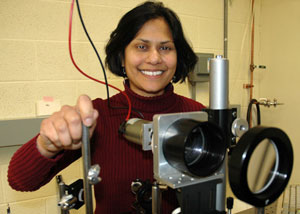Mukerji Awarded NSF Funding for Her DNA Research

Errors in genomic DNA can lead to tumors and other diseases. By probing specific DNA structures, Ishita Mukerji hopes to gain an understanding of how such medical conditions can be prevented or possibly cured.
Mukerji, professor of molecular biology and biochemistry, studies how different proteins recognize and bind to DNA. Specifically, she examines four-stranded DNA structures, known as “Holliday junctions,” which are involved in DNA repair and recombination. These are different from the common, two-stranded DNA.
On April 1, Mukerji will receive a four-year grant worth $798,368 from the National Science Foundation (NSF) to fund her research project, “Structure and Function of Holliday Junctions Complexed With Proteins Probed by Fluorescence and UV Raman Spectroscopic Methods.”
“Both DNA repair and recombination are vital functions of the cell, which are needed to maintaining a stable and active genome,” Mukerji explains. “Our goal is to study the structure of the junctions and how that relates to their function.”
Holliday junction structures can be changed by protein binding. Mukerji will examine how these structures are altered by proteins that are known to be involved in repair and recombination and are known to bind to junctions.
“These studies address the overall mechanism of how DNA recombination occurs in the cell and the function of these proteins,” she says.
Chemistry graduate students Andrew Moreno and Jon King, MBB graduate student Yan Li and molecular biology and biochemistry major Olga Buzovetsky ’10, will assist Mukerji with the ongoing research.
Two different methods are used to study the DNA interactions: fluorescence spectroscopy and a laser technique, UV resonance Raman spectroscopy. By using the fluorescence method, the Mukerji group can examine and compare the structure of the junction and the protein-binding sites. By using the Raman technique, which examines molecular vibrations, they can probe protein and ion binding sites.
Wesleyan’s Chemistry Department and Molecular Biology and Biochemistry Department own several fluorescence spectrometers, and Mukerji has built her own, specialized UV resonance Raman spectrometer.
Most of the proposed research will be completed in Mukerji’s lab, although some computational studies will be done in collaboration with David Beveridge, the University Professor of the Sciences and mathematics, professor of chemistry. She is also collaborating with the Hingorani lab (MBB department) to study how proteins involved in mismatch repair and meiotic recombination bind to Holliday junctions. One set of experiments will be conducted at SUNY Buffalo.
The group will also examine how the protein-junction complex either facilitates or suppresses certain processes.
“One theory that we have is that the proteins we are studying suppress recombination as a means of preserving or maintaining the genome.” Mukerji says. “This is an idea that will be tested with the proposed experiments.”

